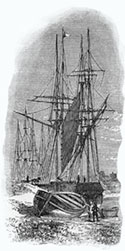Maritime History of Newport
By Peter Brown
© Peter Brown 2024
The construction of the Alexandra Docks, 1865–1914
Shipping capacity increased significantly after the extension to the Town Dock, and the 1850s also saw the construction of new railway access to the Town Dock and quays, replacing the earlier tramroads with greater capacity and efficiency.[1] These improvements allowed the Customs receipts between 1871 and 1874 to increase from £46,776 to £55,329 and the Excise receipts from £7,149 to £11,008.[2]
While the Town Dock extension helped, the scale of the increasing demand created pressure for additional dock facilities. Two competing schemes were proposed: the East Usk Railway & Docks Company to construct new docks on the east bank of the river Usk and the Alexandra Dock Company to build docks on the west bank. The issue was decided in favour of the Alexandra Dock Company, and on 6th July 1865 the Alexandra (Newport) Dock Act 1865 was passed, giving the company the authority to construct the new dock.[3] The name Alexandra honoured HRH Princess Alexandra of Denmark, who had married the Prince of Wales–later King Edward VII–in 1863.[4]
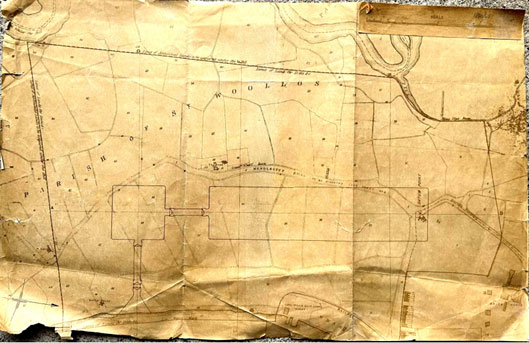
A plan of the proposed dock in 1860/65
(Photo courtesy of Monty Dart)
The North Dock 1875
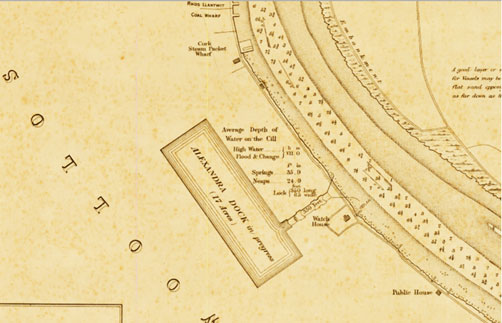
The original Alexandra Dock was under construction at the time of this 1870 survey of the river Usk. It was only known as the North Dock after the docks were extended southwards.
Note the Watch House near the entrance lock after it had been moved downriver from Watch House Parade near the Transporter Bridge.
(Newport Past website)[5]
Work commenced on 28 May 1868, when a ceremony was held where Lady Tredegar cut the first sod,[6] and on 23 April 1870, the Monmouthshire Merlin published an advert for “Navvies wanted” to apply at the dock.[7] The new facility was officially opened for mineral and general traffic on 13 April 1875,[8] following a large parade with seven bands that marched from Clarence Place via High Street, Commercial Street, Commercial Road, and Mill Parade. Owing to Lord Tredegar’s illness, the hydraulic gates were officially opened by Mrs Evans (the wife of the Mayor) as the crowds cheered, cannons saluted, and the bands played ‘Rule Britannia’ and ‘Hearts of Oak’.[9] The first ships to enter the dock were the screw steamer George Elliot, the Lady Tredegar steam tug and the schooner Lord Tredegar, but the Lord Tredegar ran too close to the dock gates and damaged her bowsprit. The George Elliot was then berthed and loaded with steam coal from the pits of the Nantyglo and Blaina Company to be shipped by the Royal Mail Steamship Company. An extremely detailed account of the day’s proceedings was published in The Western Mail on the 14th of April.[10]
After the opening, a lunch was provided at the Victoria Hall (later known as the Lyceum). While the meal was in progress, the Mayor sent a telegram to His Royal Highness–the Prince of Wales–informing him that the Alexandra Dock–named after Her Royal Highness, the Princess of Wales–had been successfully opened in the presence of 40,000 people. Within the hour, a reply was received from His Royal Highness thanking the Mayor for his message, congratulating the citizens of Newport on their new dock, and wishing them prosperity in the future.
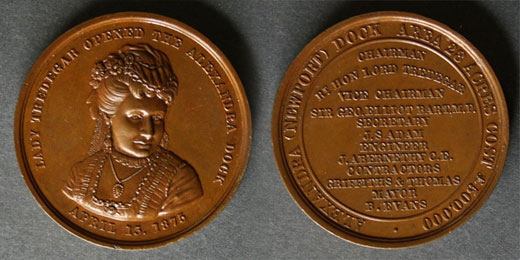
The commemorative medal to celebrate the opening of the Alexandra Dock on 13 April 1875.
The dock was actually opened by Mrs Evans, the Mayor’s wife, owing to Lord Tredegar’s illness.
(Newport Past website)[11]
The dock covered a total area of 28¾ acres and measured roughly 2,500’ by 500’; entry was gained from the Usk through an entrance lock that was 350’ long and 65’ wide. This lock was closed in 1919, following a reduction in use after the Sea Lock (opened in 1914) provided access to the North Dock via the later South Dock.[12] The closed lock was then converted into a dry dock called Messrs C. H. Bailey’s Dry Dock. This dry dock was extended to 415’ long and the lock entrance to 60’ wide by 1934 and later became The Bristol Channel Ship Repairers Ltd.
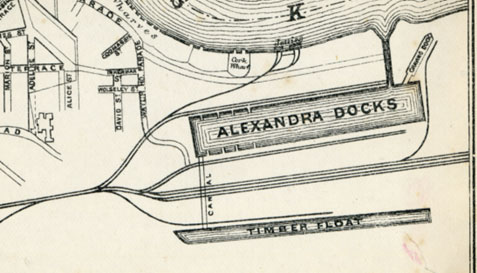
A plan of 1883 showing the first phase of the Alexandra Docks, opened in 1875, with the first timber float that opened in 1878.
(Newport Past website)[13]
In the first fortnight 25 vessels (including 6 steamers) entered the dock, with one of 1,009 tons carrying timber from Pensacola. In its first year, 982 vessels passed through the lock, and the total imports and exports amounted to 296,927 tons. The trade statistics for 1876–77 illustrate the immediate increases:[14]
Exports |
|
1876 |
1877 |
To foreign |
Coal (tons) |
566,455 |
610,776 |
|
Iron (tons) |
97,581 |
98,976 |
Coastwise |
Coal (tons) |
780,869 |
823,931 |
|
|
|
|
Foreign imports |
Iron ore (tons) |
170,813 |
343,038 |
|
Pitwood (loads) |
61,377 |
81,721 |
|
Timber (loads) |
33,909 |
49,400 |
|
Flour & Grain (cwts) |
269,741 |
303,867 |
|
Potatoes (cwts) |
233,866 |
177,526 |
|
1876 |
1877 |
||
|
Ships |
Tonnage |
Ships |
Tonnage |
Shipping Outwards |
|
|
|
|
To Foreign with cargo |
1,426 |
423,226 |
1,482 |
451,112 |
To Foreign in ballast |
23 |
7,914 |
114 |
55,104 |
Coastwise with cargo |
7,252 |
536,566 |
7,537 |
603,830 |
|
|
|
|
|
Shipping Inwards |
|
|
|
|
Foreign with cargo |
895 |
200,804 |
1,138 |
326,351 |
Foreign in ballast |
156 |
70,221 |
155 |
68,347 |
Coastwise with cargo |
2,984 |
307,670 |
2,896 |
303,535 |
The efficiency of the docks was commended in 1877 when the SS Capella discharged her ballast and loaded 1,954 tons of Powell Duffryn coal in only 33½ hours.[15]
It was the nature of shipping at the time that accidents were frequent, and many vessels foundered on journeys, often far from home. In a few instances, accidents took place at the docks, and in 1878, a schooner of Liverpool named the Chrysolite (477 tons) suffered a massive explosion while loading coal in the Alexandra Dock.[16] The blast blew the coal trimmers into the dock and caused severe injuries to the engineers and master. The ship caught fire, and it took some hours before the local fire engines regained control after four of the trimmers lost their lives.[17] The Norwegian barque Black Hawk was another example of a coal-laden ship catching fire in the dock. The reports of this event in 1891 do not mention casualties, but the ship was towed into deep water and scuttled.[18]
![Newport coal trimmers in the early 20th century.[19]](images/10coal_trimmers.jpg)
Newport coal trimmers in the early 20th century.[19]
In 1878, a timber float was opened to the west of the North Dock that ran parallel to it, measuring 10 acres in area and 8’ deep, with a connecting canal to the North Dock.[20] In 1881, the U.S. Consul at Cardiff (Wirt Sikes) reported favourably on the timber trade and noted that “Considerable quantities of this description of timber have been imported into Newport from Pensacola, Savannah, Dobay, Darien, and Brunswick.”[21] Logs were recorded individually as they were transferred to the timber float, which was kept in fresh water. A smaller timber float of 5¼ acres was added around 1930 between the earlier one and the North Dock.
The 1880s also saw significant changes to shipping in South Wales as the transition from sail to steam was moving apace.[22] The port of Chepstow diminished in traffic while docks were under construction in Barry and Cardiff, and Swansea and Penarth already had direct access to their docks from the sea. Steamers from Spain and Mediterranean ports traded regularly with Newport, and the Customs House extended its opening hours to process paperwork quickly to avoid delays. The importation of iron ore jumped from 539,309 tons in 1881 to 743,351 in 1882, around half of which was taken to the Ebbw Vale works.
An Act of 1883 transferred the Newport Dock Company’s undertaking to the Alexandra (Newport and South Wales) Docks and Railway Company, bringing the Town Dock and the Alexandra Dock under a single authority.[23] Newport then ranked as the fourth port in the kingdom for coastal coal exports, and the opening of the Rhondda Valley Railway in 1884 provided a direct link between the Rhondda coalfield and the Newport docks.
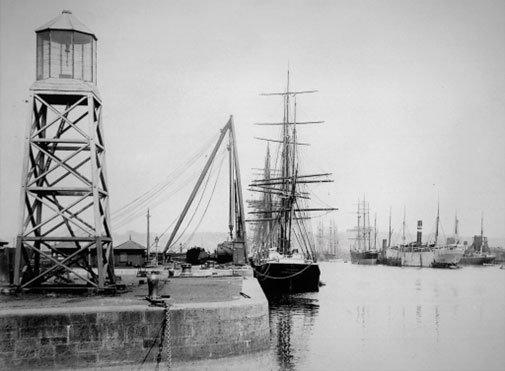
Alexandra Docks, looking north from the north–south junction, c1890.
(Unknown source)
The west side of the North Dock housed coaling hoists, and by 1914, there were both fixed and moveable types. Hoists from the Town Dock were moved to the North Dock after the former closed in 1930, but by the 1960s, the hoists had been removed.[24]
On the east side of the North Dock was the Timber Stage–960’ long–equipped by 1914 with 10 cranes and 2 warehouses.[25] After the Alexandra Docks joined the Great Western Railway (GWR) system in 1922, a programme of modernisation included reconstruction of the Timber Stage in reinforced concrete, additional storage for railway wagons, the introduction of coaling devices to empty the 20-ton coal wagons, and the replacement of hydraulically operated cranes with electric versions. The dock’s power station provided the electricity supply from the northern end of the North Dock.[26]
Another feature of the North Dock was the River Wharf next to it on the west bank of the Usk, adjoining the entrance to the dock. Plans for the Wharf were drawn up in 1904, and work commenced in 1905: the quay length was 403’, and it had four moveable cranes. After 1922, it was renamed by the GWR as the GWR Wharf, but it was closed before WWII and only reused intermittently afterwards.[27]
The South Dock 1892
Even the opening of the Alexandra (North) Dock in 1875 could not contain the pressure of expansion, and between 1877 and 1881, coal exports doubled from 610,000 tons to 1,200,000 tons, while the port's total trade was 2½ million tons by 1881.[28] The import of iron ore did not increase in the same proportion, simply due to the lack of capacity, but the export of iron more than doubled in the same period.[29]
To deal with this increased trade and ensure Newport’s place as one of the pre-eminent coal ports, plans were drawn to extend the Alexandra Dock southwards to create what became known as the South Dock. It was connected to the North Dock by a channel (the Junction Cut) 60’ wide, spanned by a hydraulically controlled swing bridge 125’ long, which also provided rail access to the original engine shed of 1875.[30]
On 30th January 1883, the first sod of the South Dock was cut by the coal owner Sir George Elliot, and when work was completed in December 1892, the South Dock measured 1,500’ in length, 650’ in width, and covered an area of 20 acres.[31] By then, Newport had advanced to the third place in the kingdom for coastwise coal exports, with 1890 shipments totalling 2,760,294 tons. The port of Newport was approved for the direct importation of tobacco in 1892.[32]
A new South Lock connected the South Dock eastwards to the river Usk when it opened in 1893.[33] The lock measured 503’ 6” by 72’, with a 25’ and 35’ water depth during spring tides. It was renamed the East Lock in 1914 when the Sea Lock was opened (forming a new ‘South Lock’) and closed during WWI, although it was still maintained as an emergency entrance until 1937 when it was filled in.[34]
A report for 1897 shows increased trade in all departments at the Alexandra and Town Docks. The main imports were iron ore, timber, pitwood and sleepers, with the main exports being iron, tinplate, coal and coke.[35] The pier known as the Tredegar Pier was also erected in 1897.[36] This was on the river, just to the east of the Pillgwenlly Pill where the Tredegar Dry Dock was opened in 1902.
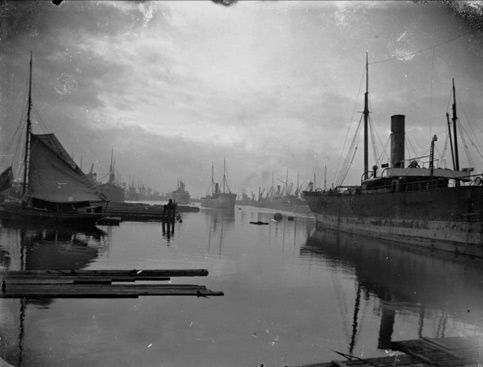
Alexandra Docks looking south, c.1905.
Photographer: Martin Ridley (1861–1936).[37]
Reproduced by kind permission of Llyfrgell Genedlaethol Cymru – The National Library of Wales, under a Creative Commons Licence for non-commercial, educational purposes.
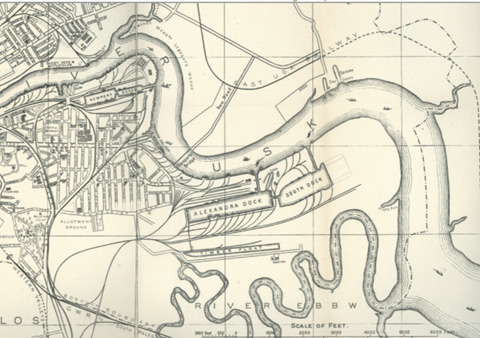
The Alexandra Docks are shown here on a plan of 1905, just before the South Dock was extended and the Sea Lock was constructed. The Transporter Bridge opened the following year.
(Newport Past website)[38]
The Transporter Bridge
Between 1869 and 1889, various schemes were put forward for connecting the two banks of the river, which is tidal, while still allowing tall-masted ships to use the river without hindrance. The Corporation obtained Parliamentary sanction in 1869 to operate a ferry and again in 1889 to build and maintain a pedestrian subway under the river, but neither scheme became a reality.[39]
The problem was tackled again in 1898 when proposals for ferries, subways, high-level, bascule, swing, lifting and rolling bridges were considered. It was then decided to build a transporter bridge because it would cost considerably less than a subway capable of taking vehicular traffic or a high-level bridge with sloping approaches. A swing bridge was rejected, partly because it was felt that the large piers required would obstruct river traffic. There was also a reason that swing bridges of ordinary width could only be navigated safely against the stream, and the Usk has only a relatively short period of high tide when shipping movement is possible. A transporter bridge, it was thought, would not obstruct shipping and could be built for a sum that would not prove too heavy a drain on the Corporation's finances.
In 1899, the Docks Company took over the Pontypridd, Caerphilly and Newport Railway, and in the same year, Messrs Lysaghts constructed a wharf for the foreign trade of their new steelworks on the east bank of the Usk.[40] In 1900, Parliamentary sanction was obtained for the erection of the Transporter Bridge in agreement with Lysaghts, where the Corporation pledged a river crossing in return for their establishment of the steelworks in Newport.[41]
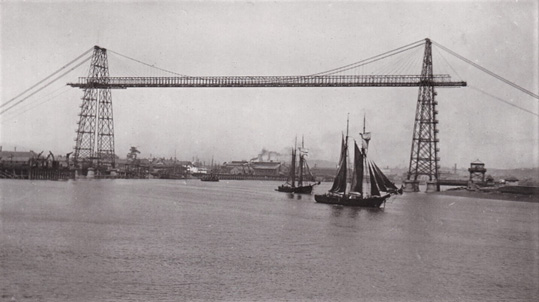
A photograph of the Transporter Bridge taken in the early 20th century. From a postcard by Ernest T Bush.
(Newport Past website)
The South Dock extension and the Sea Lock
The expansion of the port facilities in the later 19th century was still insufficient to match the increasing demand, so in June 1905, work commenced on the most significant single expansion of the dock facilities. By July 1907, the work was nearing completion, and the dock machinery was erected concurrently with the dock construction.[42] The South Dock extension opened in November 1907, contractors having taken only 2 years to excavate an area that increased the capacity from 20 to 48 acres.[43] This had been achieved by working day and night using artifice; during these excavations, a section of the river Ebbw was diverted, and the old river bed was incorporated into the dock area.[44] The total water surface of the Alexandra Docks increased to 96 acres, with a depth of 33’.[45] The first vessel was loaded in the new section on 20 November 1907, while other construction work was still under way with the South Quay wall unfinished.[46]
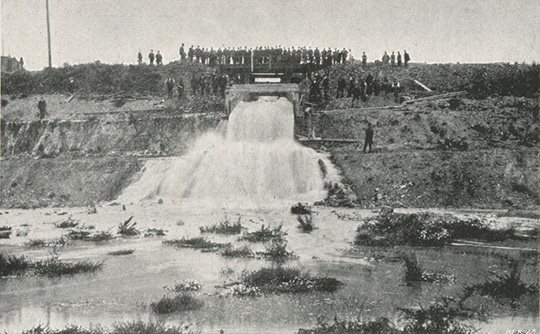
Letting water into the South Dock extension on 21 September 1907. The water was obtained from the existing docks and by pumping from the rivers Ebbw and Usk.
(Newport Past website)
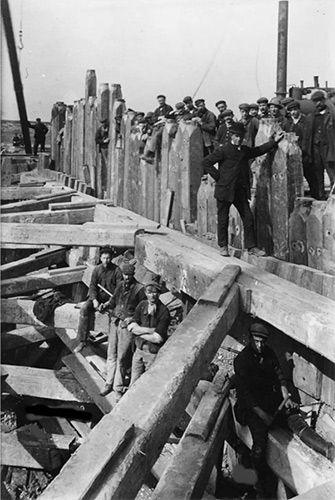
The construction of the Alexandra Dock extension in 1908, taken from an original glass plate.
(Photo from Brian Batters, courtesy of Richard Wood)
To allow road and rail access to the South Quay, a roller bridge was built across the South Lock in 1909, with a travel of 107’.[47] The South Quay had a concrete wall 3,600’ long, and by 1914 had 20 hydraulic cranes. The length was sufficient to berth nine vessels of an average length of 400’, with associated warehousing.[48] The West Quay also housed a series of huge coal hoists, where the railway trucks were run to discharge their cargo into ships.[49] The East Quay, built in 1904, had eight hydraulic cranes and a large warehouse.[50]
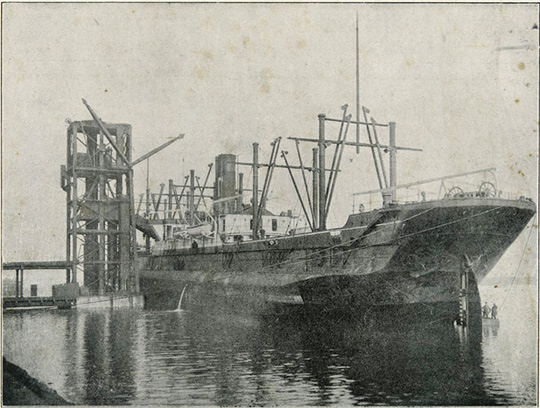
A coal hoist at the Alexandra Docks in 1914. For more information, follow the link.[51]
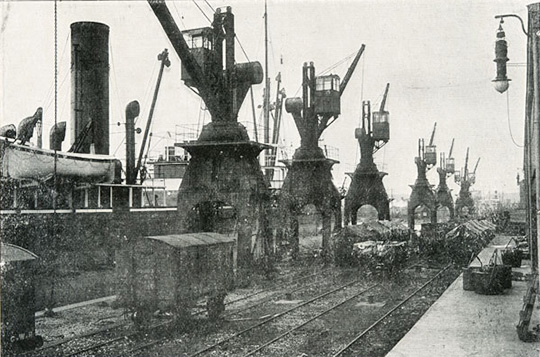
The East Quay wall, which was brought into use in 1905, was 800’ long and was equipped with eight powerful hydraulic cranes, six of 3 tons, and two of 6 tons lifting capacity.
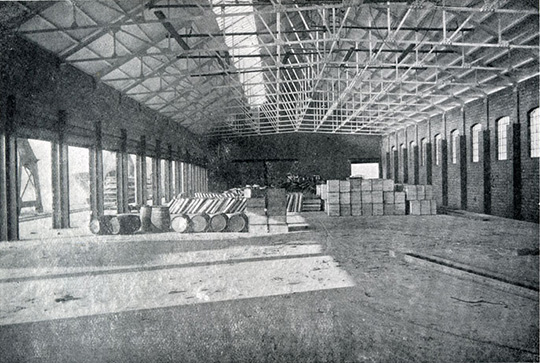
The East Quay in 1914. For more details of the warehouse follow this link.[52]
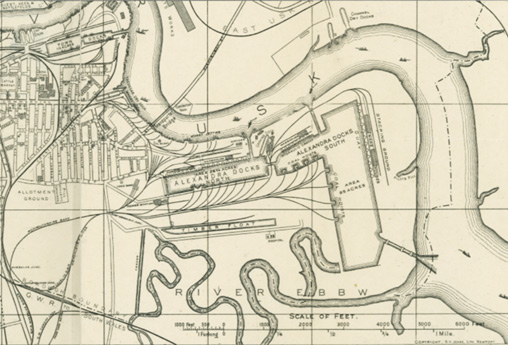
The Alexandra Docks in 1916, after the final expansion.
The Town Dock is also shown in the upper left-hand corner, close to the dry docks at Jack’s Pill.
(Newport Past website)[53]
This would be the last major work carried out on developing the port facilities of Newport, which had begun over 70 years earlier, in 1835, when work commenced on the Town Dock. This last phase of construction was critical, not only because it extended the area of the dock by another 28 acres but also because it was in this phase that the new South Lock, or Great Sea Lock, was constructed. When completed, the lock allowed shipping to enter the docks directly from the Bristol Channel for the first time. At over 1,000’ long and 100’ wide, it was claimed that the lock was the largest in the world and ensured that Newport could easily accommodate the largest ships then afloat.[54]
The construction of the Sea Lock came at a terrible price for Newport. During the construction work in 1909, the timber shoring collapsed into a trench, leaving many men trapped underneath and unable to escape. Despite the brave efforts of rescuers, 39 men could not be saved before the rising tide engulfed the trench. This story is told in detail by Monty Dart at this link.[55]
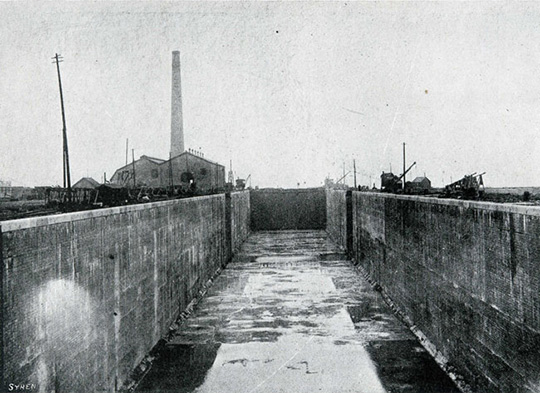
The Sea Lock was completed in 1914.
(Newport Past website)
This final expansion of the docks also required additions to the infrastructure to support activities. These included the extensive railway network (shown in the 1916 plan above) to allow access, as well as a new engine shed at Pill that opened in 1898. The railway network had grown steadily since the tramroads at the start of the 19th century, through the introduction of steam locomotives, the requirements of the Town Dock, and finally, the requirements of the Alexandra Docks up to their completion in 1914. This is a major subject that requires a separate study, and so is not covered in detail here.
There was also a requirement for power to supply the various needs of the docks and a hydraulic power station was built at the north end of the North Dock. A 1914 description explains the functions of the power station:[56]
By means of the power derived from this single Station, the whole of the Company's coal hoists and hydraulic cranes is at present worked. Every ton of coal shipped, every ton of general cargo stowed or discharged, has been operated by the power derived from that source, the total for one year now aggregating over seven million tons, a record for a single Station.
In addition to the coal shipping appliances and cranes, the power derived from this installation also operates the Lock Gates of the North Lock, South Lock, and New Lock; the Rolling Bridge over the South Lock, and the Swing Bridge over the Junction between the North and the South Alexandra Docks, as well as a large number of Capstans.
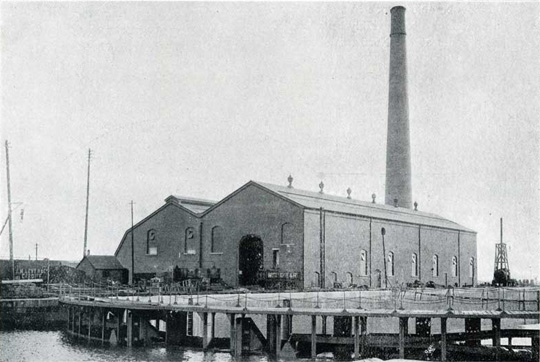
The pumping and electrical power station in 1914.
(Newport Past website)
The power station comprised a brick building that contained the engine house, boiler house, pump house and economiser house. The chimney stack was 140’ high, close to three storage and controlling accumulators. The engine house had four horizontal pumping engines, three installed in 1903 and the fourth in 1907. Most of the hydraulic power was replaced by multi-stage electric pumps in 1956, and the building later became the main intake electrical substation for the docks.[57]
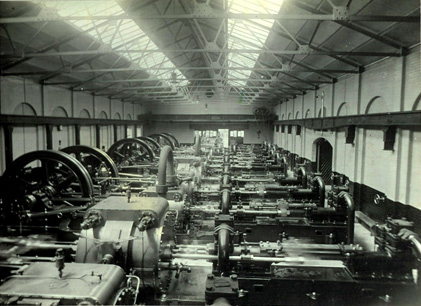
The Engine House contained four sets of horizontal triple-expansion surface-condensing pumping engines arranged transversely. Follow the link for further details.[58]
(Newport Past website)
There was a plan to invite the Prince of Wales to open the new dock while also opening the Welsh Agricultural Society’s Show at Newport in July 1914, but this did not happen.[59] Instead, the South Lock was officially opened on 14th July 1914 by Prince Arthur of Connaught, the son of Queen Victoria (not the son of George V, as is often claimed). Lord Tredegar’s steam yacht, the Liberty, became the first ship to pass through the lock when it transported Prince Arthur to the docks during the celebrations.[60] A short film of the Liberty entering the dock can be seen at this link.[61]
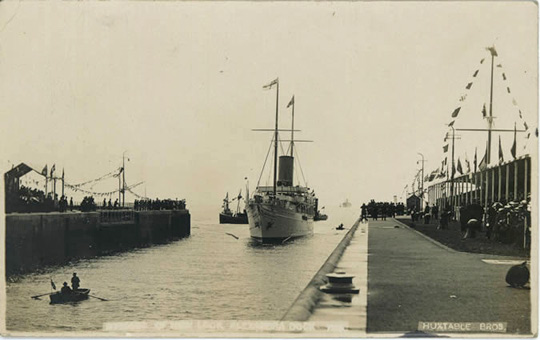
The Liberty at the opening of the South Lock.
(Newport Past website)
Later in the year that the Sea Lock was opened, a record was set when the Union Castle liner Kenilworth Castle entered the Alexandra Docks. She was 570’ long, 64’ broad, and had a gross tonnage of 12,975. With a crew of 200, she was carrying troops from Bombay to Europe.[62]
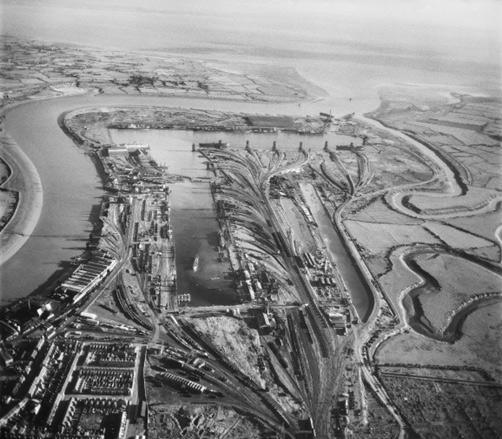
This aerial photograph of the Alexandra Docks was taken in 1947, but it shows the final layout of the docks after the work in 1914.
Creator: Aerofilms Ltd. (09/10/1947)
Courtesy of the Royal Commission on the Ancient and Historical Monuments of Wales.
Reproduced under a Creative Archive Licence for non-commercial and educational purposes.
References
1 Skillern, William J. (1960) ‘The Railways of Newport’, The Railway Magazine, July, No. 711, Vol. 107.
Online at: http://www.newportpast.com/transport/rail.php
2 Dawson, J. W. (1932) Commerce and Customs: A History of the Ports of Newport and Caerleon, 81.
Online at: https://archive.org/details/commerce-and-customs-newport
3 Newport Harbour Commissioners website, https://www.newportharbourcommissioners.org.uk/
4 Hutton, John (1996) The Newport Docks & Railway Company, Wadenhoe: Silver Link Publishing, 7.
5 https://www.newportpast.com/gallery/maps/river_usk_1870.htm
6 Western Daily Press, 29 May 1868. (British Newspaper Archive).
7 (British Newspaper Archive).
8 Dawson, 81; The Sunday Times, 18 April 1875.
9 http://www.newportpast.com/nfs/y70t79/y1875.htm
10 ‘Opening of the Alexandra Dock, Newport’, The Western Mail, 14 April 1976, 6. (British Newspaper Archive).
11 https://www.newportpast.com/gallery/potpourri/php/photo_page.php?search=%20&pos=45
12 Hutton, 9.
13 https://www.newportpast.com/gallery/maps/m1883.htm
14 Dawson, 81–2.
15 South Wales Daily News, 30 October 1877. (British Newspaper Archive).
16 Dawson, 110.
17 Pontypool Free Press, 8 June 1878. (British Newspaper Archive).
18 Sheffield Evening Telegraph, 21 February 1891.
19 Knight, Cliff V. (1984), Pillgwenlly: Newport Again, Risca: The Starling Press, 121.
20 Hutton, 21.
21 Information from Monty Dart.
22 Dawson, 82.
23 Dawson, 83.
24 Hutton, 17.
25 Hutton, 15.
26 Hutton, 26.
27 Hutton, 21.
28 Hutton, 7, 9.
29 ‘Extension of the Alexandra (Newport) Dock’, Star of Gwent, 2 February 1883. (British Newspaper Archive).
30 Hutton, 27; Newport Harbour Commissioners website.
31 Newport Harbour Commissioners website.
32 Dawson, 84.
33 Newport Harbour Commissioners website.
34 Hutton, 27.
35 Knight, Cliff V. (1985) Pillgwenlly: Newport, The Changing Times, Risca: Starling Press, 16.
36 Dawson, 84.
37 https://en.wikipedia.org/wiki/Martin_Ridley
38 https://www.newportpast.com/gallery/maps/m1905.htm
39 Mayne, L. Bruce (1959) ‘Newport's Transporter Bridge: A Graceful Colossus of Steel’, the Meccano Magazine, Vol. XLIV, No. 6, June 1959.
40 Dawson, 84.
41 Mayne (1959).
42 Dawson, 85.
43 https://www.newportpast.com/gallery/photos/php/photo_page.php?search=rail&pos=178
44 Newport Harbour Commissioners website.
45 Hutton, 36–37.
46 Dawson, 85.
47 Hutton, 27.
48 Hutton, 38.
49 Hutton, 47.
50 Hutton, 44.
51 https://www.newportpast.com/gallery/photos/php/photo_page.php?search=coal%20hoist&search2=yyyyyy&pos=6
52 https://www.newportpast.com/gallery/photos/php/photo_page.php?search=south%20dock&search2=yyyyyy&pos=18
53 https://www.newportpast.com/gallery/maps/m1916.htm
54 Newport Harbour Commissioners website.
55 https://www.newportpast.com/md/dock_disaster/index.htm
56 http://www.newportpast.com/gallery/photos/php/photo_page.php?search=wo&search2=&pos=1282
57 Info from members of the Facebook group ‘Newport Docks & River Wharves’, 10/9/2023.
58 https://www.newportpast.com/gallery/photos/php/photo_page.php?search=power%20station&search2=yyyyyy&pos=8
59 Western Daily Express, 29 January 1914.
60 Newport Harbour Commissioners website.
61 https://player.bfi.org.uk/free/film/watch-worlds-biggest-lock-opened-at-newport-by-prince-arthur-of-connaught-1914-online?fbclid=IwAR3hubnoVNWEkiT_a16vZz5WDoOCvH8-sTJXzV1jqRtNqr2EgHy2vWTtfVs
62 Western Mail, 28 December 1914. (British Newspaper Archive).
Back to Index of Peter Brown's "Maritime History of Newport "

